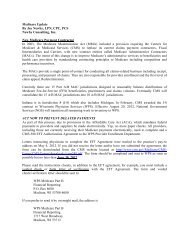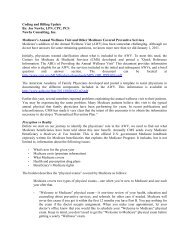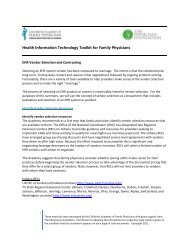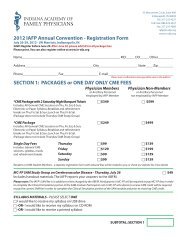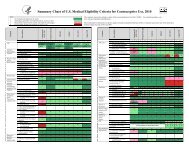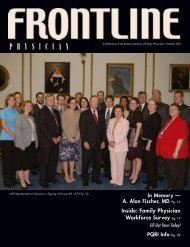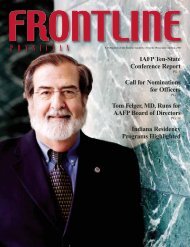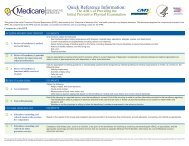pqri measure coding and reporting principles - Indiana Academy of ...
pqri measure coding and reporting principles - Indiana Academy of ...
pqri measure coding and reporting principles - Indiana Academy of ...
You also want an ePaper? Increase the reach of your titles
YUMPU automatically turns print PDFs into web optimized ePapers that Google loves.
Note codes 11055-11057 are reported based on the number <strong>of</strong> lesions involved. Only one code would be<br />
used to describe the procedure based on the number <strong>of</strong> lesions pared or cut. For example, if the physician<br />
pared three (3) corns. The physician would report 11056. This code is to be used to report two to four<br />
lesions.<br />
Removal <strong>of</strong> Skin Tags<br />
Regardless <strong>of</strong> the method <strong>of</strong> removal (e.g., scissoring, sharp method, ligature strangulation,<br />
electrosurgical destruction, or combination <strong>of</strong> treatment modalities including chemical or<br />
electrocauterization <strong>of</strong> wound, with or without local anesthesia), codes 11200-11201 are used to report the<br />
service.<br />
Note these codes are based on the number <strong>of</strong> skin tags involved. Code 11201 is an add-on procedure that<br />
cannot be reported without 11200. Multiple surgical procedures rules do not apply to add-on codes. For<br />
example, 20 skin tags are removed.<br />
The service should be reported as:<br />
11200 1 unit<br />
11201 1 unit<br />
Shaving <strong>of</strong> Epidermal or Dermal Lesions<br />
According to CPT, Shaving is the sharp removal by transverse incision or horizontal slicing to remove<br />
epidermal <strong>and</strong> dermal lesions without a full-thickness dermal excision. This includes local anesthesia,<br />
chemical, or electrocauterization <strong>of</strong> the wound. The wound does not require suture closure.<br />
Physicians sometimes refer to this procedure as a shave biopsy. If the term shave biopsy is used, the coder<br />
needs to verify if the entire lesion was shaved (11300-11313) or if a piece <strong>of</strong> tissue was removed to be<br />
sent for pathology (11100 <strong>and</strong> 11101).<br />
The shaving codes (11300-11313) are defined by size <strong>and</strong> anatomical site. Each lesion removed by shave<br />
technique is coded separately. Multiple surgical procedure rules apply to these codes.<br />
Excision Benign Lesions<br />
Benign excision is defined as full-thickness (through the dermis) removal <strong>of</strong> lesions <strong>of</strong> the skin or<br />
subcutaneous tissue (e.g., cicatricial, fibrous, inflammatory, congenital, cystic lesions, etc.). Simple<br />
closure is included in the excision code; however, intermediate or complex closure may be reported<br />
separately for excised diameter greater than 0.5 cm. When both the excision <strong>and</strong> repair codes are reported,<br />
multiple surgical procedure rules apply.<br />
The excision <strong>of</strong> benign lesion codes (11400-11446) are defined by size (including margins) <strong>and</strong><br />
anatomical site. Each lesion excised is coded separately. Multiple surgical procedure rules apply to these<br />
codes.<br />
Excision <strong>of</strong> Malignant Lesions<br />
Malignant lesion excision is defined as full-thickness (through the dermis) removal <strong>of</strong> malignant lesions<br />
(pathology report available) <strong>of</strong> the skin or subcutaneous tissue. Closure by suture is required when using<br />
codes 11600-11646. Simple closure is included in the excision code; however, intermediate or complex<br />
closure may be reported separately. When both the excision <strong>and</strong> repair codes are reported, multiple<br />
surgical procedure rules apply.<br />
5-18<br />
*All CPT Codes, Descriptions, <strong>and</strong> Two-Digit Modifiers<br />
Only Are Copyright 2006 American Medical Association. GEN 2007 REV 07-01<br />
Copyright 2007 Newby Consulting, Inc.



